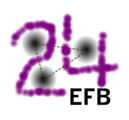Speaker
Description
We investigated three-nucleon force (3NF) effects in the Final State Interaction (FSI) configuration of the $d (n,nn) p$ breakup reaction. Solutions of the 3N Faddeev equations $[1]$ with the CDBonn nucleon-nucleon potential $[2]$ and the Tucson-Melbourne 3NF $[3]$ give access not only to the elastic scattering observables but also to the three-body breakup ones. In this contribution we focus on an integrated breakup cross section around the final state interaction condition for two neutrons:
$
{d ^2 \sigma \over d\Omega_1 d\Omega_2 } \equiv \left. \int _{S_0-\Delta S}^{S_0+\Delta S}
{d^3 \sigma \over d\Omega_1 d\Omega_2 dS} dS \right|_{\Omega_1 = \Omega_2}
~~~~~ ( n + d \to p + (nn) ) ~~~~~~~~~~~~~~~~~~~~~~~~~~~~~~~~~~~~~(1)
$
Here $\Omega_1$ and $\Omega_2$ represent the directions of the momenta of outgoing neutrons 1 and 2, respectively. For fixed $\Omega_1$ and $\Omega_2$, the arc-length variable $S$ defines uniquely the three-nucleon kinematics, yielding a specific $(E_1,E_2)$ point on the allowed kinematical curve in the $(E_1,E_2)$ plane, where $E_1$ and $E_2$ are the kinetic energies of neutron 1 and 2, respectively. Choosing an appropriate starting point where $S=0$, $S$ is calculated as a distance taken along the curve from its starting point:
$
S= \int dS = \int \sqrt {(dE_1)^2 + (dE_2)^2 } ~~~~~~~~~~~~~~~~~~~~~~~~~~~~~~~~~~~~~~~~~~~~~~~~~~~~~~~~~~~~~~~~~~~~~~~~~~~~~~~~~~~(2)
$
where $E_1$ and $E_2$ are the kinetic energies of neutron 1 and 2, respectively. The FSI occurs at the condition $E_1=E_2$ at the parameter $S=S_0$.
Fig.1 shows the integrated breakup cross section of Eq.(1) at the incident neutron laboratory energy $E_{lab}$=200 MeV with the averaging width parameter $\Delta S$= 20 MeV. The angle $\theta_{lab}$ is the laboratory scattering angle of nucleons 1 and 2, for which the FSI condition is realized.
![Integrated final state interaction configuration breakup cross section for the incident neutron laboratory kinetic energy 200 MeV. The theoretical predictions based solely on a two-nucleon interaction (here the the CDBonn potential $[2]$) are represented by the dotted line, while the results obtained with the two-nucleon potential augmented by the the Tucson-Melbourne 3NF $[3]$ are shown with the solid line.](https://www.mns.kyutech.ac.jp/~kamada/WITALA/PROG/Fig1.png)
We found a large deviation between the theoretical predictions including or not including 3NF. Although the 3NF effects for the elastic scattering cross section are located predominantly in the region starting from middle up to backward scattering angles,the 3NF effects for the integrated FSI configuration breakup cross section are found also at forward scattering angles.
- W. Gloeckle, H. Witala, D. Hueber, H. Kamada, J. Golak, Phys. Rep. 274, 107 (1996).
- R. Machleidt, Phys. Rev. C 63, 024001 (2001).
- S. A. Coon, H. K. Han, Few Body Syst. 30,131 (2001).




